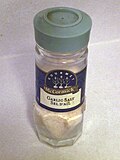List of edible salts
List of Edible Salts
Edible salt, also known as table salt or just salt, is a mineral composed primarily of sodium chloride. It is essential for life in general, and saltiness is one of the basic human tastes. Salt is used in cooking, is often present in a great many processed foods, and is also used as a preservative. There are many different types of edible salts available, each with its own unique characteristics and uses. This article provides a list of some of the most common types of edible salts.
Sea Salt
Sea salt is produced through evaporation of ocean water or water from saltwater lakes, usually with little processing. Depending on the water source, this leaves behind certain trace minerals and elements. The minerals add flavor and color to sea salt, which also comes in a variety of coarseness levels.
Table Salt
Table salt is more heavily processed to eliminate minerals and usually contains an additive to prevent clumping. Most table salt also has added iodine, an essential nutrient that helps maintain a healthy thyroid.
Himalayan Pink Salt
Himalayan pink salt is harvested from the Khewra Salt Mine in Pakistan. It gets its pink color from trace minerals, like magnesium, potassium, and calcium.
Kosher Salt
Kosher salt is flaky and coarse-grained, and is easy to pick up with your fingers. It's often used in recipes that call for a "pinch" of salt.
Celtic Salt
Celtic salt, also known as grey salt, is harvested from tidal ponds off the coast of France. The salt crystals are raked out of the ponds, and the mineral-rich, slightly greyish water gives the salt its color.
Fleur de Sel
Fleur de Sel, or "flower of salt," is harvested by hand from sea salt ponds. The top layer of salt is delicately skimmed off the top, and what's left is a flaky salt that's excellent for finishing dishes.
Black Salt
Black salt, also known as Kala Namak, is a type of rock salt, a salty and pungent-smelling condiment used in South Asia. It is also used in many vegan recipes to mimic the taste of eggs.
Smoked Salt
Smoked salt is slow-smoked over a wood fire to absorb the flavor of the smoke, and can be used to give dishes a smoky flavor.
Pickling Salt
Pickling salt is used in pickling and canning to ensure a crisp final product. It does not contain any added iodine or anti-caking agents.
Rock Salt
Rock salt is a large crystal salt that is a slightly grayish color. It is less refined and still contains minerals that are removed from normal table salt.
Conclusion
There are many other types of edible salts not listed here. Each has its own unique flavor profile and uses in the kitchen. It's worth experimenting with different types to find out which ones you prefer for different uses.
List of edible salts
Transform your life with W8MD's budget GLP-1 injections from $125.
W8MD offers a medical weight loss program to lose weight in Philadelphia. Our physician-supervised medical weight loss provides:
- Most insurances accepted or discounted self-pay rates. We will obtain insurance prior authorizations if needed.
- Generic GLP1 weight loss injections from $125 for the starting dose.
- Also offer prescription weight loss medications including Phentermine, Qsymia, Diethylpropion, Contrave etc.
NYC weight loss doctor appointments
Start your NYC weight loss journey today at our NYC medical weight loss and Philadelphia medical weight loss clinics.
- Call 718-946-5500 to lose weight in NYC or for medical weight loss in Philadelphia 215-676-2334.
- Tags:NYC medical weight loss, Philadelphia lose weight Zepbound NYC, Budget GLP1 weight loss injections, Wegovy Philadelphia, Wegovy NYC, Philadelphia medical weight loss, Brookly weight loss and Wegovy NYC
|
WikiMD's Wellness Encyclopedia |
| Let Food Be Thy Medicine Medicine Thy Food - Hippocrates |
Medical Disclaimer: WikiMD is not a substitute for professional medical advice. The information on WikiMD is provided as an information resource only, may be incorrect, outdated or misleading, and is not to be used or relied on for any diagnostic or treatment purposes. Please consult your health care provider before making any healthcare decisions or for guidance about a specific medical condition. WikiMD expressly disclaims responsibility, and shall have no liability, for any damages, loss, injury, or liability whatsoever suffered as a result of your reliance on the information contained in this site. By visiting this site you agree to the foregoing terms and conditions, which may from time to time be changed or supplemented by WikiMD. If you do not agree to the foregoing terms and conditions, you should not enter or use this site. See full disclaimer.
Credits:Most images are courtesy of Wikimedia commons, and templates, categories Wikipedia, licensed under CC BY SA or similar.
Contributors: Prab R. Tumpati, MD







